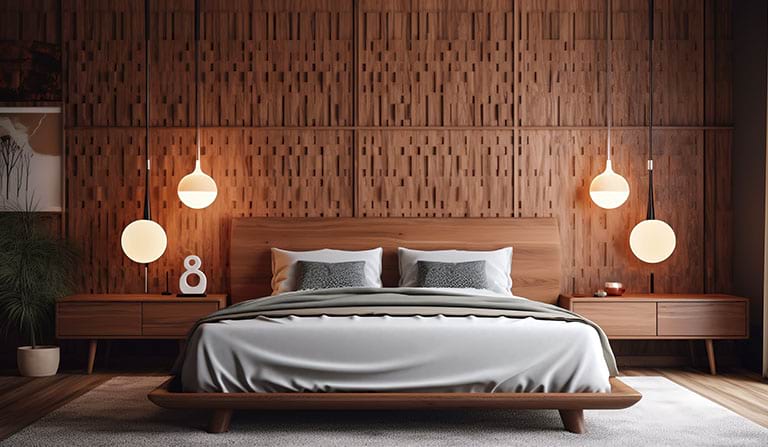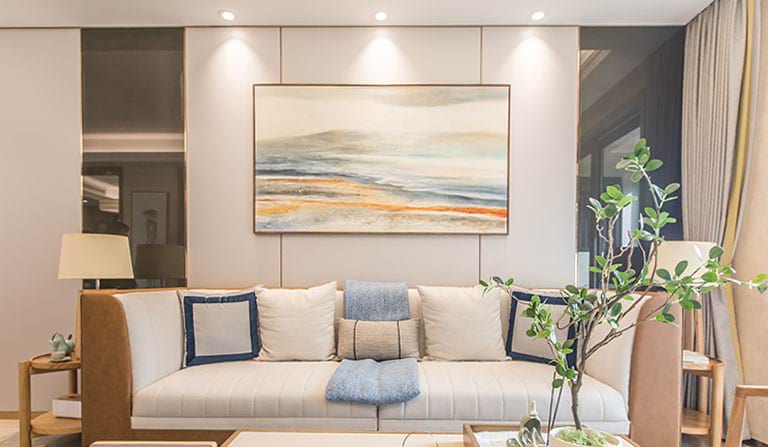Living Room Light: An In-depth Guide for Living Room Lighting
A living room light can significantly contribute to establishing a cozy and welcoming environment for you and your visitors. Lighting plays a pivotal role in setting the ideal mood. The possibilities for illuminating your living room, from ceiling lights to accent lights, are limitless.
In this all-inclusive manual, we’ll delve into diverse lighting choices for your living area and guide you on integrating them into your space for an impressive, harmonious appearance.
Overhead Lighting
The primary illumination in a room usually comes from overhead lighting, often supplied by a fixture attached to the ceiling such as a chandelier, pendant, or a flush mount light.
These lighting fixtures not only serve a functional purpose but can also enhance the aesthetic appeal of your living room.
When choosing an overhead light, it’s crucial to consider the dimensions of your living room and the elevation of your ceilings.
A spacious living room with tall ceilings would necessitate a larger light fixture to generate sufficient light, whereas a more diminutive room with lower ceilings might be better suited to a smaller fixture.
Accent Lighting
Accent lighting serves to emphasize particular attributes or items within a space, for instance, architectural components, plants, or art pieces.
This kind of illumination can be realized using floor lamps, wall sconces, table lamps, or track lighting.
Accent lighting not only adds an aesthetic appeal to your living room but also supplements more light sources.
Picking out accent lighting that aligns with the overall aesthetic of your area and augments the appearance of the elements you wish to spotlight is vital.
Task Lighting
Task lighting is a distinct kind of lighting designed to light up particular tasks like reading, writing, or cooking. It can be introduced in a living room through items like table lamps, floor lamps, or fixtures attached to the wall.
When you are choosing task lighting for your living room, take into account the kind of tasks for which you’ll be using the light and where the light will be positioned.
For instance, a table lamp situated beside a reading chair will offer suitable light for reading, whereas a floor lamp positioned at a room’s corner can offer extra light for different tasks.
Ambient Lighting
Ambient illumination pertains to the general illumination level within a space.
This kind of illumination can be attained via overhead lights, natural light sources, or supplementary lighting.
For a lounge or living area, it’s crucial to establish an agreeable level of ambient illumination that offers a cozy and welcoming environment.
This ambiance can be established using dimmer switches that let you regulate your light’s intensity to match the room’s mood and ongoing activities.
Creating a Cohesive Look
In terms of illumination ideas for the living area, it’s critical to establish a unified appearance by skillfully blending various types of lighting. This can be accomplished using a variety of light sources, including ceiling lights, accent lights, task lights, and general ambient lights.
Integrating lighting into the design of your living room can amplify the overall aesthetic and ambiance of your area, making it a cozy and appealing space for you and your visitors. There’s a wide array of lighting alternatives to suit your individual style and preferences, whether you prefer a subtle, refined touch or a striking impression.
The importance of lighting ideas for a living room in creating a welcoming and comfortable space cannot be overstated. The appropriate lighting can elevate a room’s aesthetic appeal, set a certain mood, and provide practical utility. There’s a vast selection of lighting ideas for living rooms, ranging from ceiling lights to table lamps, and from wall lights to standing lamps. To craft the ideal atmosphere, consider the room’s function, your personal style, and the color scheme of your furnishings. With some imagination and a basic understanding of lighting, you can design a breathtaking and practical living room that you and your guests will adore.
Common Questions about Living Room Lighting
What is the best lighting for a living room?
Optimal illumination in a living room is dictated by its function and your individual aesthetic preferences. If your goal is to cultivate a snug and private ambiance, think about integrating a welcoming table light, an assortment of standing lamps, or a dimmer to manage the intensity of your ceiling lights. For purpose-specific lighting, a freestanding or desk lamp positioned next to a reading seat or couch could be a suitable choice. If your objective is to accentuate a specific artwork, a wall lamp or a track lighting system might be the ideal solution. It’s recommended to employ a mixture of diverse lighting styles to generate a harmonious and appealing living room ambiance.
What is the best lighting for a TV room?
In designing a television room, the goal is to establish a setting that is not only cozy but also low in the glare. The lighting in such a room should strike a balance – it should be sufficiently illuminating for relaxed viewing, yet not so intense as to create screen glare. Think about incorporating a mix of general lighting like a ceiling light or wall-mounted fixtures, and specific lighting like a desk or standing lamp, to fashion a warmly lit, inviting area. The inclusion of a dimmer switch can provide the flexibility to modify the light intensity as per your preference.
How do I make “cozy” lighting in my living room?
For comfortable illumination in your lounge, think about utilizing gentle, warm light fixtures like desk lamps, standing lamps, or wall fixtures. Steer clear of intense ceiling lights that can be stark and overbearing. Rather, choose a mix of general and focused lighting that fosters a warm and welcoming environment. Incorporating a dimmer switch also aids in adjusting the light intensity to generate a snug setting.
What is the best lighting for an open floor plan?
In an open floor layout, it’s essential to establish a unified, well-illuminated environment. Think about utilizing a mix of overhead lighting options, like a ceiling lamp or track lighting, combined with floor or table lamps for focused lighting. Wall-mounted lights can be used to emphasize certain sections or to instill a warm, inviting ambiance. Dimmer switches are handy in an open floor design, as they let you modify the light intensity according to your requirements.
How tall should a lamp be beside a sofa?
When positioning a light fixture next to a couch, the common guideline is to select a lamp that is roughly at the same level as the couch’s armrest. This contributes to establishing a harmonious and unified aesthetic in the space. If your couch is a bit lower, a taller lamp might be a good choice to maintain the balance. If you’re uncertain, the best approach is to determine the height of your couch and pick a lamp that matches its proportions, to guarantee a sophisticated and harmonious appearance in your sitting room.







Leave a comment
You must be logged in to post a comment.